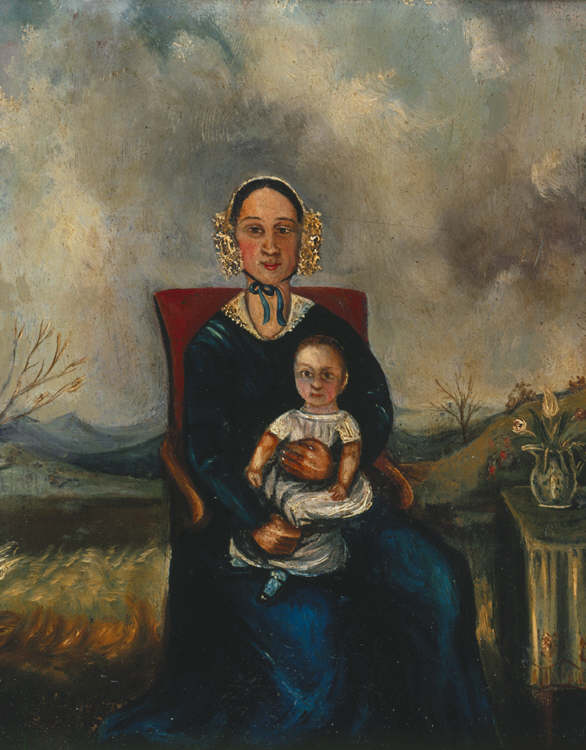In Carmarthenshire Museum in Abergwili are two portraits painted in 1850 in oil on board by an artist called David Patrick. They don’t seem to have attracted much attention outside the Museum, except by Paul Joyner, but both possess a strange attraction, and deserve to be better known.
Little is known about David Patrick. He was born in February 1822 in Carmarthen. It’s said he was a sailor in his youth. In the 1850s he lived with his wife Eliza, whom he’d married in 1847, in Jackson’s Lane, Carmarthen, where he tried to earn a living as a portrait painter. Presumably he met with little success, because, whereas in the 1851 census he was described as an ‘artist’, in the 1861 and succeeding censuses he’s listed as a ‘house painter’ or ‘house decorator’. He died in Carmarthen on 16 December 1899, eight years after his wife’s death.

These are the only two paintings by Patrick that seem to have survived. One is a portrait of Mary Williams and her young daughter Sarah, who lived in Chapel Street, Carmarthen. Mary’s husband, John, whom she married in 1848, is the subject of the other portrait. John was a carpenter and probably made the wooden frames surrounding each picture.

It seems likely that David Patrick was self-taught as a painter, and received little or no formal training in the craft. His ‘naïve’ style is close to that of several other painters in nineteenth century Wales, like Hugh Hughes, William Roos and W.J. Chapman, whom Peter Lord terms ‘artisan artists’. They served a demand from the rising middle classes for portraits to commemorate their standing in Welsh society. A carpenter would not have been able to afford the services of a ‘society’ portraitist, nor to buy portraits on a large scale: Patrick’s pictures are small, no more than 28.5cm x 22cm.
In his portrait John Williams stands outdoors, erect in his best (or only) formal suit, possibly the one he got married in. Beneath his dark jacket he wears a patterned waistcoat, a white shirt and a bow tie, and in his left hand he holds a tall hat by its brim. His wide eyes stare at us under long geometrical eyebrows. He’s combed his dark hair carefully for the occasion. His cheeks, enclosed between bushy whiskers, are red, and his nose is shiny. There’s a hint of a smile on his lips, though the wrinkles on his forehead, by contrast, suggest anxiety.
As interesting as the figure of John Williams is the wintry landscape behind him. It’s sketched in roughly, but well enough to make out sun-fringed clouds about a darker sky, and a view of hills in the distance, suggestive of the Tywi valley; higher ground to the right might signify the foothills of the Black Mountain. There are plants and grasses on either side of the figure in the foreground.

Mary Williams sits in an upholstered armchair, and with her left hand she holds her daughter upright on her lap. Both of them hold the viewer in an unblinking stare. Sarah, the young child, has a white dress and a wide-eyed expression. Mary wears a deep blue full-length dress with an out-turned collar fringed with pearls at the neck, and a bonnet tied with a blue ribbon under her chin. The seated, mother-and-baby composition, the blue dress and the frontal gaze all recall the Madonnas of early Renaissance painting. But, despite some red in her cheeks, our Mary looks thin and wan.
Behind Mary is a second winter landscape. The foreground is similar to that in the other painting, brown and withered grassland, except that Mary’s left is a small table with a glass jug containing a few whitened flowers. Further back, two leafless trees. There’s another hilly landscape; this time, the hills look higher, and there’s no valley. The sky holds rain clouds, with only a faint suggestion of blue.
How, you wonder, did Mary and John react when David Patrick delivered the two portraits to them? They might have appreciated the likenesses, and the impression the images give of Victorian respectability. John stands full-square, proud of his craft and his family. Mary too seems stately in her quasi-religious pose. But, at least for us, there’s something unsettling and poignant in both pictures. Their wintry setting seems to fix a chill air around the figures, suggesting a hard, rather than a fruitful, future ahead. It’s almost as if Samuel Beckett had written the stage directions for what lies behind the figures. And we happen to know that, within six years of her portrait being painted, Mary Williams would be dead, and John and Sarah left alone in the world.

Leave a Reply